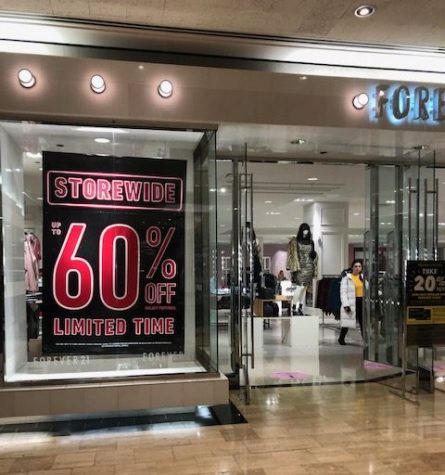Why wear then waste? Fast fashion’s impact on the environment
January 23, 2020
Under Armour, American Eagle, H&M, Nike, The Gap, Old Navy and Zara, just to name a few, are some of the most popular and wealthiest clothing brands in the United States. All of these big brands have one thing in common: they are all considered fast fashion brands. Fast fashion can be defined as inexpensive clothing being produced rapidly by mass-market retailers in response to the latest trends. All of these stores offer trendy, yet affordable, clothing, but buying from these brands comes at a cost: the fair treatment of garment workers and the environment.
It was recently revealed that one of fast fashion’s biggest brands, Forever 21, filed for bankruptcy and is beginning to close down stores across the nation.
“Forever 21 will close 200 stores, leaving the fast-fashion chain with a smaller footprint to help it emerge from Chapter 11,” CNN reporter Evelina Nedlund said.
Fast fashion is one of the largest factors in American’s wastefulness today. An average person throws away 80 pounds of textiles per year as a result of trying to stay on-trend. The fashion industry is the second most polluting industry, beaten out only by the oil industry.
Overall, the fast fashion industry encourages wastefulness; it makes the consumers believe that there are 52 clothing seasons in one year over the typical two fashion seasons: spring and fall. By encouraging consumers to buy clothes weekly, the fast fashion industry then responds by placing cheap, oftentimes poorly made, garments into consumers’ hands. They’re made this way so consumers will then have to buy a replacement. It is hard to resist fast fashion in American society today as almost every brand you could find at your local shopping mall uses it to get ahead of competitors. In the end, a majority of textile brands either burn the excess clothing they are unable to sell-causing air pollution- or they throw the garments into landfills.
“[The fashion industry] sends 13 trillion tons of our clothes to landfills in the U.S. alone.” Ayesha Barenblat, the founder of clothing brand Remake, said. “They sit for 200 years leaving toxic chemicals and dyes to contaminate local soil and groundwater.”
Although fast fashion is highly prevalent in our society today, countless brands, “slow fashion” brands stand up against the fast fashion industry. To be considered an ethical or slow fashion brand, the company must consider the processes and resources required to make the clothing, produce better quality garments, enforce the fair treatment of workers or use organic materials. The slow fashion movement encourages customers to buy higher quality garments less frequently.

Barenblat has stated that it takes a garment worker 18 months to earn what a fashion brand CEO makes on their lunch break, and the average worker is paid 1-2 dollars an hour. These staggering statistics have caught the attention of various ethical clothing brands including Patagonia, Outdoor Voices, Everlane, Reformation, People Tree, Eileen Fisher and many more.
“We’re losing the planet because of climate change, that’s the elephant in the room,” Patagonia founder Yvon Chouinard said. “Society is basically working on symptoms. Save the polar bear? If you want to save the polar bear, [then] you got to save the planet.”
Patagonia produces durable, high-quality outdoor apparel and gear. Patagonia belongs to the Sustainable Apparel Coalition; they use organic cotton, frequently use recycled fabrics and have publicly denounced the fast fashion industry. Patagonia’s operating officer, Doug Freeman, criticized the fast fashion industry and noted, “hyper-consumption is absolutely killing the planet.”
The rise in “slow fashion” brands is vital in decreasing the fashion industry’s impact on the environment; however, in comparison to the hundreds of clothing brands and businesses, “slow fashion” or ethical brands only make of a small fraction. Over time, it saves money to invest in a more durable, expensive item that does not need to be replaced. Consumers can make the choice to only buy from ethical brands, limit clothing purchased annually, use reusable shopping bags over paper or plastic bags, donate or upcycle old clothing. There are many resources out there to help; the app Good On You provides sustainability ratings, and there are numerous high-end, high-quality second-hand stores like ThredUp and TheRealReal that offer high-quality clothing at a lower cost to the environment.
Just like clothing store owner Meghan Kinney said “whether we need to cut off a sleeve, turn a dress into a top or turn a sweater into a jacket, we don’t need to be wasteful. We just need to be creative.”


